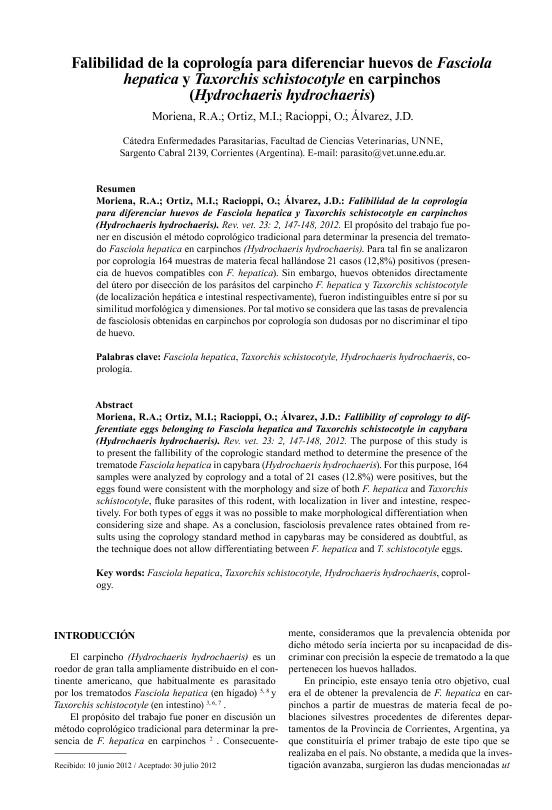Mostrar el registro sencillo del ítem
dc.contributor.author
Moriena, Ricardo Antonio

dc.contributor.author
Ortiz, Maria Isabel

dc.contributor.author
Racioppi, O.
dc.contributor.author
Álvarez, J. D.
dc.date.available
2023-10-30T18:08:52Z
dc.date.issued
2012-12
dc.identifier.citation
Moriena, Ricardo Antonio; Ortiz, Maria Isabel; Racioppi, O.; Álvarez, J. D.; Falibilidad de la coprología para diferenciar huevos de fasciola hepatica y taxorchis schistocotyle en carpinchos (hydrochaeris hydrochaeris); Universidad Nacional del Nordeste. Facultad de Ciencias Veterinarias; Veterinaria; 23; 2; 12-2012; 147-148
dc.identifier.issn
1668-4834
dc.identifier.uri
http://hdl.handle.net/11336/216456
dc.description.abstract
El propósito del trabajo fue poner en discusión el método coprológico tradicional para determinar la presencia del trematodo Fasciola hepatica en carpinchos (Hydrochaeris hydrochaeris). Para tal fin se analizaron por coprología 164 muestras de materia fecal hallándose 21 casos (12,8%) positivos (presencia de huevos compatibles con F. hepatica). Sin embargo, huevos obtenidos directamente del útero por disección de los parásitos del carpincho F. hepatica y Taxorchis schistocotyle (de localización hepática e intestinal respectivamente), fueron indistinguibles entre sí por su similitud morfológica y dimensiones. Por tal motivo se considera que las tasas de prevalencia de fasciolosis obtenidas en carpinchos por coprología son dudosas por no discriminar el tipo de huevo.
dc.description.abstract
The purpose of this study is to present the fallibility of the coprologic standard method to determine the presence of the trematode Fasciola hepatica in capybara (Hydrochaeris hydrochaeris). For this purpose, 164 samples were analyzed by coprology and a total of 21 cases (12.8%) were positives, but the eggs found were consistent with the morphology and size of both F. hepatica and Taxorchis schistocotyle, fluke parasites of this rodent, with localization in liver and intestine, respectively. For both types of eggs it was no possible to make morphological differentiation when considering size and shape. As a conclusion, fasciolosis prevalence rates obtained from results using the coprology standard method in capybaras may be considered as doubtful, as the technique does not allow differentiating between F. hepatica and T. schistocotyle eggs.
dc.format
application/pdf
dc.language.iso
spa
dc.publisher
Universidad Nacional del Nordeste. Facultad de Ciencias Veterinarias
dc.rights
info:eu-repo/semantics/openAccess
dc.rights.uri
https://creativecommons.org/licenses/by-nc-nd/2.5/ar/
dc.subject
FASCIOLA HEPATICA
dc.subject
TAXORCHIS SCHISTOCOTYLE
dc.subject
HYDROCHAERIS HYDROCHAERIS
dc.subject
COPROLOGIA
dc.subject.classification
Otras Ciencias Biológicas

dc.subject.classification
Ciencias Biológicas

dc.subject.classification
CIENCIAS NATURALES Y EXACTAS

dc.title
Falibilidad de la coprología para diferenciar huevos de fasciola hepatica y taxorchis schistocotyle en carpinchos (hydrochaeris hydrochaeris)
dc.title
Fallibility of coprology to differentiate eggs belonging to fasciola hepatica and taxorchis schistocotyle in capybara (hydrochaeris hydrochaeris)
dc.type
info:eu-repo/semantics/article
dc.type
info:ar-repo/semantics/artículo
dc.type
info:eu-repo/semantics/publishedVersion
dc.date.updated
2023-05-29T12:39:43Z
dc.journal.volume
23
dc.journal.number
2
dc.journal.pagination
147-148
dc.journal.pais
Argentina

dc.journal.ciudad
Corrientes
dc.description.fil
Fil: Moriena, Ricardo Antonio. Universidad Nacional del Nordeste. Facultad de Ciencias Veterinarias; Argentina
dc.description.fil
Fil: Ortiz, Maria Isabel. Consejo Nacional de Investigaciones Científicas y Técnicas. Centro Científico Tecnológico Conicet - Nordeste; Argentina. Universidad Nacional del Nordeste. Facultad de Ciencias Veterinarias; Argentina
dc.description.fil
Fil: Racioppi, O.. Universidad Nacional del Nordeste. Facultad de Ciencias Veterinarias; Argentina
dc.description.fil
Fil: Álvarez, J. D.. Universidad Nacional del Nordeste. Facultad de Ciencias Veterinarias; Argentina
dc.journal.title
Veterinaria
dc.relation.alternativeid
info:eu-repo/semantics/altIdentifier/url/https://repositorio.unne.edu.ar/handle/123456789/48993
Archivos asociados
